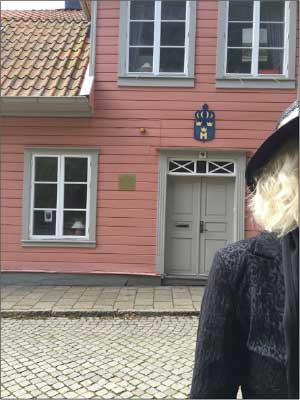Kungälv, Sweden – A European Physical Society Historical Site
By Ivan K. Schuller, University of California, San Diego
If you are an ice hockey fanatic, you may have heard of Kungälv city in Sweden. Several National Hockey League (NHL) players are originally from there, although to the best of my knowledge none had a "hat trick." If you are a physics fanatic, you should have heard of Kungälv since it possibly is the birthplace of nuclear fission. Legend has it that on a snowy 1938 Christmas, during a Kungälv walk with her nephew Otto Frisch, Lise Meitner for the first time discussed the interpretation of German experiments as due to nuclear fission. A testimony to the fact that ideas and love for physics cannot be constrained by politics, physical boundaries, or even the lack of major resources.
Kungälv is a friendly Swedish little city located close to Denmark and Norway. As with many European towns, Kungälv was at various times part of different countries and has a rich (by American standards) history. A visit to the city has as major attractions the Bohus Fortress and the Brackboden cookie and biscuit store. Surprisingly and unlike in most visits to historical places, a tour of the city invariably includes the house where a physicist, Lise Meitner lived on and off.
Lise Meitner had a complex personal history and a very distinguished scientific career. She was born in an Austrian Jewish family, converted to Christianity, and in spite of this had to escape from Germany in 1938 for being Jewish. She studied physics and received a doctorate from the University of Vienna, held a permanent position at the Kaiser-Wilhelm Institute in Berlin, the Academy of Sciences in Stockholm, and the Royal Institute of Technology, during a time when none of these were common for women. She is credited as being instrumental in other important discoveries besides nuclear fission, such as the long-lived isotope of Protactinium and the Auger effect.
Her scientific relationships are checkered with a "who is who" in science; Planck, Boltzmann, Hahn, Bohr, Siegbahn, Chadwick, Szilard, Delbrück, and many others. She received numerous prizes, membership in many academies of science, and was honored by the National Press Club.
Quite uniquely, a variety of names were given to honor her including element 109-meitnerium, craters in planets, asteroids, streets, parks, plays, and major scientific prizes. This year the European Physical Society designated the Uddmanska house (Västra gatan 9) where Lise Meitner lived in Kungälv, as an EPS Historic Site. Considering the contributions of Lise Meitner to Physics she certainly should be credited with a Physics "hat trick."
Further information can be found at:

Photograph shows the Uddmanska house (Västra gatan 9) where Lise Meitner lived in Kungälv, an EPS Historic Site. Her spirit is present there even today.
